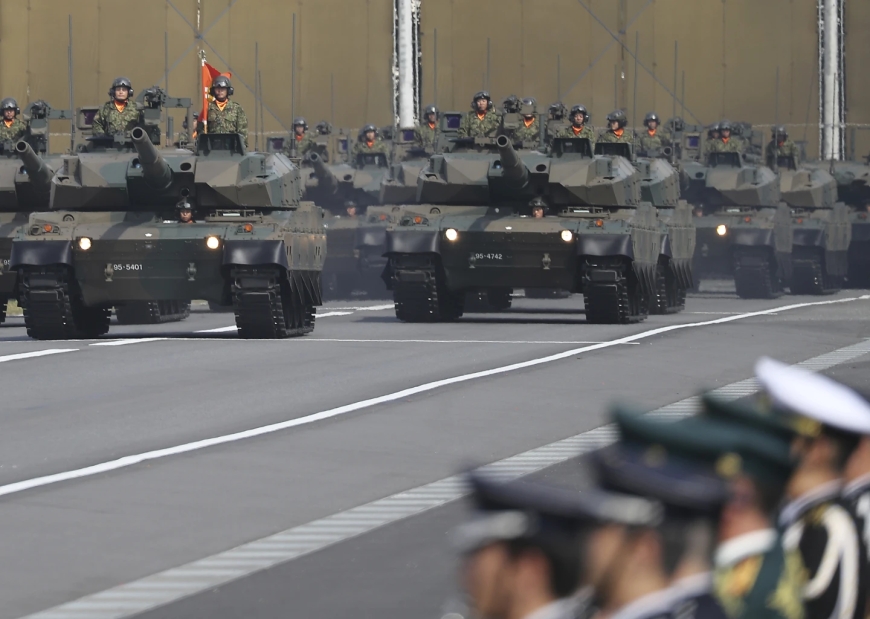Japan's Defense Ministry Seeks Record $59 Billion Budget Amid Growing Chinese Threat
In response to escalating tensions in the Asia-Pacific region, Japan’s Defense Ministry on Friday requested an unprecedented 8.5 trillion yen ($59 billion) budget for the 2025 fiscal year. This record-breaking proposal is part of a broader strategy to bolster Japan's defense capabilities, particularly in its southwestern islands, where the nation faces an increasing threat from China.

In response to escalating tensions in the Asia-Pacific region, Japan’s Defense Ministry on Friday requested an unprecedented 8.5 trillion yen ($59 billion) budget for the 2025 fiscal year. This record-breaking proposal is part of a broader strategy to bolster Japan's defense capabilities, particularly in its southwestern islands, where the nation faces an increasing threat from China.
The budget request, if approved, will mark the third year of Japan’s ambitious five-year military expansion plan, which aims to double annual defense spending to approximately 10 trillion yen by 2027. This plan, set to cost 43 trillion yen ($297 billion) over five years, is expected to elevate Japan to the world’s third-largest military spender, trailing only the United States and China.
Strategic Focus on Technological Advancements and Island Defense
The Defense Ministry's proposal emphasizes the need to strengthen Japan's deterrence capabilities, particularly against the backdrop of China's growing military assertiveness in regional waters. The budget allocates significant resources to enhance Japan’s strike-back capabilities, including the development and procurement of long-range missiles and advanced launch systems, such as those aboard Aegis-class destroyers.
A substantial portion of the budget—970 billion yen ($6.7 billion)—is dedicated to these enhancements, which are seen as crucial in countering the threat from hypersonic missiles developed by China, North Korea, and Russia. These missiles, which are harder to detect and track, pose a significant challenge to Japan’s defense infrastructure. Additionally, about one-third of this allocation is earmarked for a satellite constellation designed to improve Japan's ability to detect missile-related activities.
Addressing Workforce Challenges with AI and Unmanned Systems
Japan's shrinking population and declining birth rates have led to a shortage of military personnel, prompting the Defense Ministry to focus on unmanned systems and artificial intelligence (AI) to fill the gap. The ministry is seeking 103 billion yen ($710 million) to expand its drone fleet for surveillance and combat operations. These "game-changing" unmanned systems are expected to play a pivotal role in Japan’s future military strategies, enabling longer missions and reducing the risk to human life.
In addition to drones, the budget request includes 314 billion yen ($2.17 billion) for the construction of three new multi-purpose compact destroyers, each requiring only 90 crew members—less than half the number needed for existing vessels. This reduction in crew size reflects Japan’s broader strategy of leveraging technology to compensate for its shrinking workforce.
The Defense Ministry also plans to introduce AI-driven surveillance systems at 40 Self-Defense Force (SDF) bases across Japan, a project estimated to cost 18 billion yen ($124 million). This initiative is expected to free up approximately 1,000 service members for other duties. Furthermore, 4.3 billion yen ($29.7 million) is requested for the development of automated supply storage systems in Okinawa, slated for completion by 2027.
Recruitment and Retention Challenges
Japan’s Self-Defense Forces have been struggling to meet recruitment targets amid a declining youth population and stiff competition from private companies offering better pay and benefits. Last year, the SDF managed to recruit only half of its target of 19,598 personnel, the lowest in its 70-year history. Moreover, 6,258 mid-career personnel left the force, the highest attrition rate in three decades.
The ministry's interim report, also released on Friday, underscores the urgent need for reforms to improve recruitment and retention. It highlights the necessity of creating a more attractive work environment, offering better training and learning opportunities, and providing enhanced support for working mothers. These measures are seen as crucial in addressing what the report describes as "the worst recruiting environment since the end of World War II."
The Defense Ministry has also been grappling with internal challenges, including a series of sexual assault, harassment, and corruption scandals. Last year, an internal investigation revealed attempts to cover up these incidents and a lack of accountability among supervisors. The ministry has pledged to address these issues, which have further complicated efforts to attract and retain talent.













































